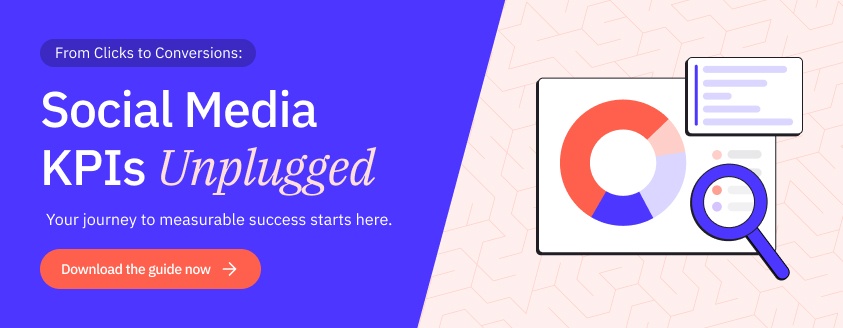Ever found setting measurable goals for your social media marketing efforts stressful or confusing?
I sure did.
Between the sea of metrics to track and initiatives to pursue, it's incredibly easy to get overwhelmed.
And when you add all the algorithm changes and content types you need to be aware of, it gets a little too much!
Having done a fair share of setting social media goals in my career (and learning a great deal from the best agencies and marketers), we compiled a simple yet effective guide with plenty of practical examples to help you on your journey.
So if you're looking to up your data game for the new year, a new quarter, or are simply rethinking your approach, read on!
- Setting realistic social media goals & KPIs for social media
- Methods for setting KPIs for social media marketing goals
- Measuring success in social media marketing
- How to adapt your social media strategy based on poorer performance
- Prefer to learn visually?
Watch our webinar recording on setting measurable social media goals
Setting realistic social media goals & KPIs
My best starting advice on any goal-setting is to always figure out the broader objective a specific marketing channel can help you achieve. We'll be talking about social media marketing specifically, but these techniques can be applied across all mediums.
Remember: Different businesses have different needs.
Your current objective could be as simple as increasing trust and building a community through regular post updates. Or, it could be much more data-driven, and you'd only consider your efforts successful when you're helping generate a certain number of bookings or sales per month.
Without knowing key business metrics, the brand's ideal customer persona, and their buyer's journey, it's hard to come up with a meaningful strategy and measurable social media goals (or any marketing channel for that matter).
To get inspiration, find out the key business metrics for the brand you're working with. Figure out what success looks like for them. Then, come up with a way of using social media marketing to push them towards achieving those social media goals.
Once that has been decided upon, choosing the right goal and metrics to track will become much easier. Promise!
Plus, you'll be able to prioritise work better and stay focused when the next shiny new feature or platform comes around (which we all know will continue happening 😉).
The three most common social media goals you can use in your strategy
There are three overarching social media goals you could set when managing social media for a business:
📣 Increase brand awareness
Usually, this is the most common goal since social media platforms are best for creating relevant content and engaging with target audience. Here, you'd measure success by the number of followers, reach and impressions, and engagements like shares and comments.
🙋♀️ Generate leads
This social media goal helps drive interest in products and services while supporting other marketing and sales initiatives. This is usually measured by the number of direct messages and enquiries received, plus visits to the website from social channels.
🛍 Sell a product or service
This goal is tricky, but since Facebook and Instagram have launched shopping functionality within their apps, it's no longer just about paid advertising! Here you'd look out for the number of attempted or completed purchases and their value coming from social accounts.
There is also one other social media goal you could consider, and it's to show up and continually build trust with new customers. Having an active social media presence is a perfectly fine goal, and it's often the most appropriate choice for new businesses or established brands just starting out on social media. In this case, goal-tracking is similar to increasing brand awareness with a focus on building trust and creating a community instead of pure engagements.
Once you've picked the main social media marketing goals, we can set the right KPIs (Key Performance Indicators)!
Methods for setting KPIs for social media marketing goals
🎯 Goal-setting method #1: Set monthly or quarterly KPIs
Setting KPIs can be pretty intimidating stuff, but when done well, they'll help you connect bigger initiatives with day-to-day activities and measure how well you're doing compared to previous periods.
To set KPIs correctly, you'll need your primary social media goal, some historical data, and a realistic approach to the resources available to you.
Your historical data and consideration of available resources are extremely important. Unless your clients or your team are ready to spend ten times more on social media management, it's not wise to expect you'll get five or ten times the results.
Borrow our example KPIs for each of the main social media goals, and adjust them as you see fit:
- Awareness: receive an average of 1,000 engagements per month across all social media channels (including comments and shares).
- Lead gen: generate 15 enquiries on average per month via Facebook and Instagram OR attract 1,000 new visitors to the website in Q4 from social media channels.
- Sales: sell 10 items OR goods worth $500 per month with the help of Instagram.
🎯 Goal-setting method #2: Set SMART social media goals for projects
If you're in digital marketing, you've probably heard of SMART goals:
SMART = Specific. Measurable. Attainable. Relevant. Time-based.
These, too, can be used to set measurable KPIs to guide and attribute your efforts on social media. That said, I've personally found that SMART social media goals work the best for project-based work that focuses on bigger initiatives rather than measuring month-over-month (MoM) performance.
Also, keep in mind that while SMART goals can help guide what content you'll be creating, it will take longer to say that you've been successful (or not). Which, in an agency setting, could be a luxury you simply don't have as you need to show results on a monthly basis.
Here are some ideas on using the SMART social media goal-setting methodology for campaigns:
- Awareness: increase our average engagement rate by 15% by using UGC (user-generated content) throughout the holiday season.
- Lead gen: increase our total reach by 10% by increasing our posting by 100% and spending 2 hours on social listening per day throughout Q3.
- Sales: increase the number of sales enquiries received by 50% by creating BTS (behind-the-scenes) content throughout Q4.
As you can see above, these are tougher to measure than one said metric but could prove extremely useful if you're pitching stakeholders to spend more time on social.
Measuring success in social media marketing
When measuring the effectiveness of your social media marketing efforts, there's no lack of places where to look!
- Google Analytics
- Native social media platforms
- Your scheduling tool (like Sendible)
- Your CRM tool
- & your gut feeling!
However, staring at data individually and comparing it to odd time periods is not going to build a bigger picture. You need to be clear on what you're looking for first, and those will be directly linked to your social media goals.
For example, an e-commerce shop will probably care about direct sales and impressions gained via their followers sharing content when compared to a dentist's office, whose focus will most likely be on building trust and getting more enquiries.
5-minute intro to Google Analytics
Google Analytics is a free, comprehensive tool that helps you better understand your acquisition efforts.
You can use it to measure your efforts on social media and how they fit into the overall digital marketing strategy.
If you're a beginner - don't worry. It's not as overwhelming when you know where to look!
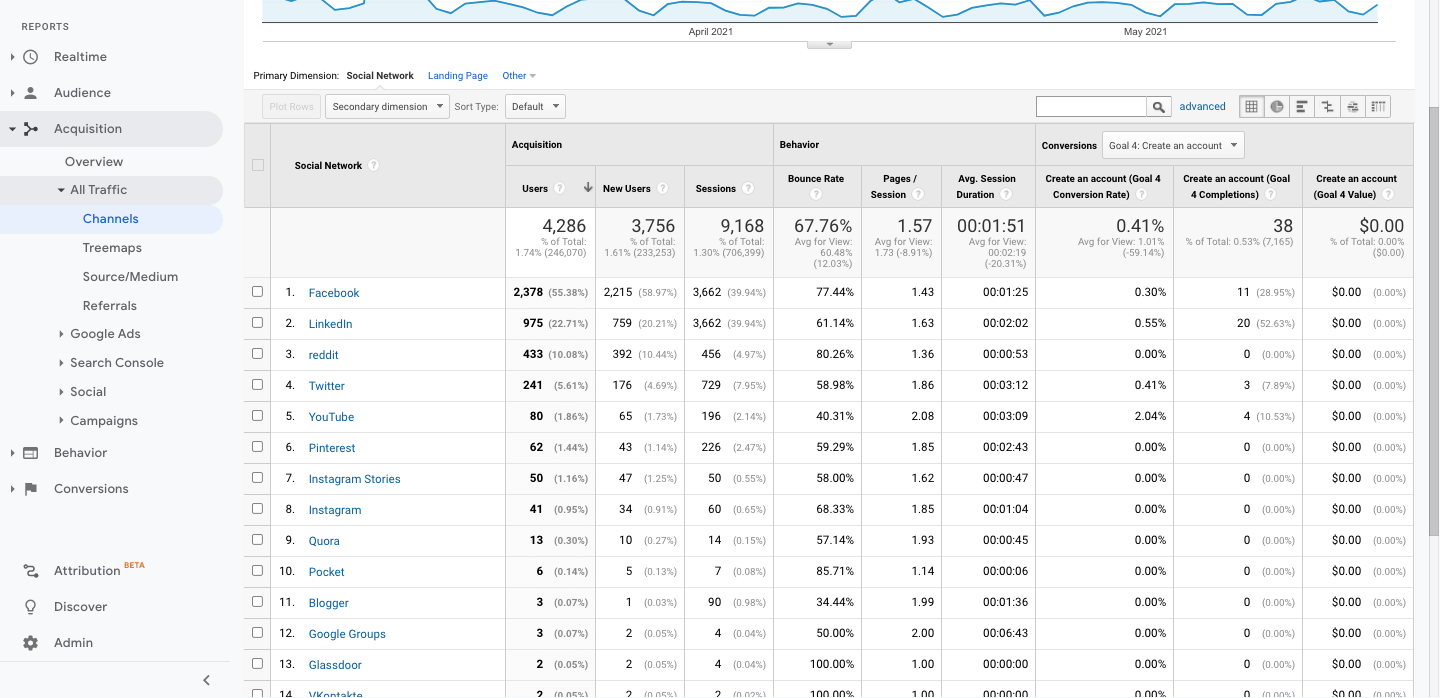 Image credit: Google Analytics - Channels view
Image credit: Google Analytics - Channels view
One of my favourite places to look in GA is: Path: Acquisition > All Traffic > Channels
Here you can:
- See all the different acquisition channels in one place
(organic & paid) - Analyse how Social compares to other channels
( # count & % percentage) - Plus, it's also available in Sendible
(in the 'Reports' Hub)
You can then drill down further to see how each social media channel contributes to the total traffic gained from all social media channels.
Tracking results on native social media platforms
Native platforms are a fantastic resource if you want to dig deeper into the quality and effectiveness of your content.
Here are some of our favourite areas and reports to check out per social media network:
Metrics on native platforms: Facebook
- Organic vs Paid results
- Full view of post clicks, reactions, comments, and shares
- 'Pages to Watch' for competitors and industry leaders
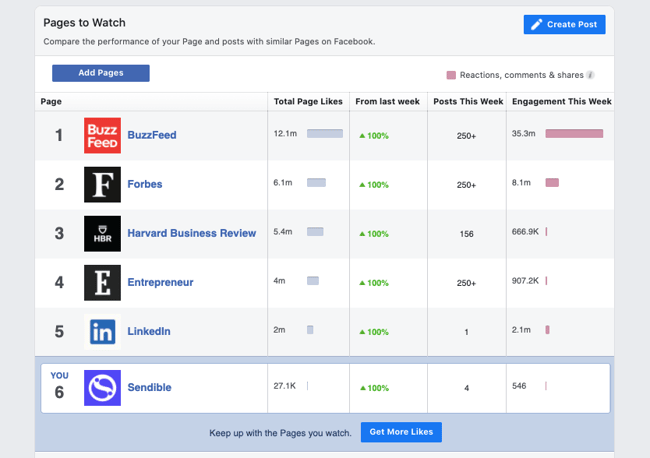 Image credit: Facebook Business Manager - Pages to Watch
Image credit: Facebook Business Manager - Pages to Watch
Social media metrics on native platforms: Instagram
- Toggle different metrics to see individual post and story performance (reach, profile visits)
- Check frequently: The overall engagement data is stored for 7 and 30 days
- Metrics for Stories, Reels, and IGTV
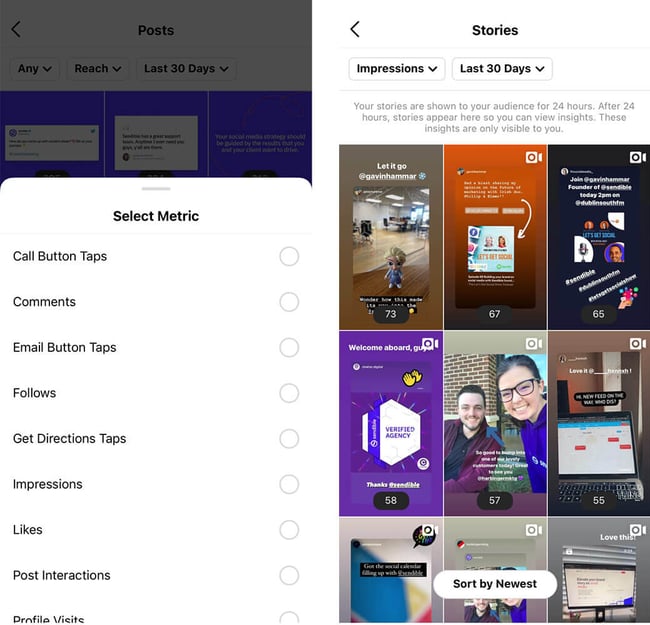 Image credit: Instagram Business analytics on the mobile app
Image credit: Instagram Business analytics on the mobile app
Social media metrics on native platforms: Twitter
- Birds-eye view monthly summaries
- Engagement rate % for every post
- Deeper insights into video content
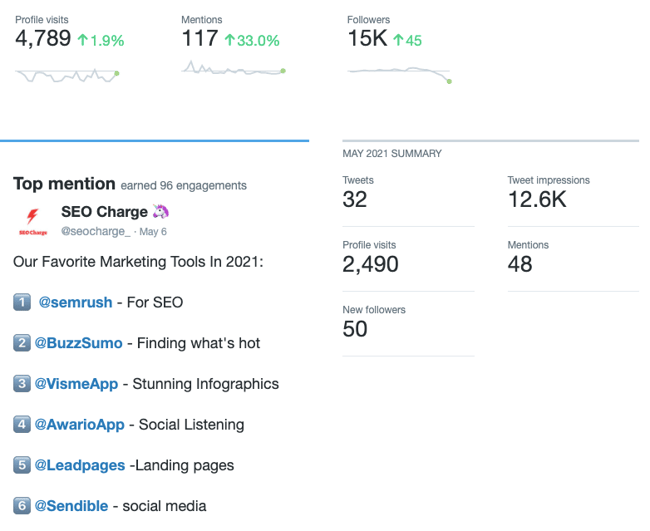 Image credit: Twitter analytics - Monthly report
Image credit: Twitter analytics - Monthly report
Social media metrics on native platforms: LinkedIn
- Engagement rate % + click-through rate (CTR) on individual posts
- Companies to track: Watch competitors, frequency of their posting and average engagement rate on their posts
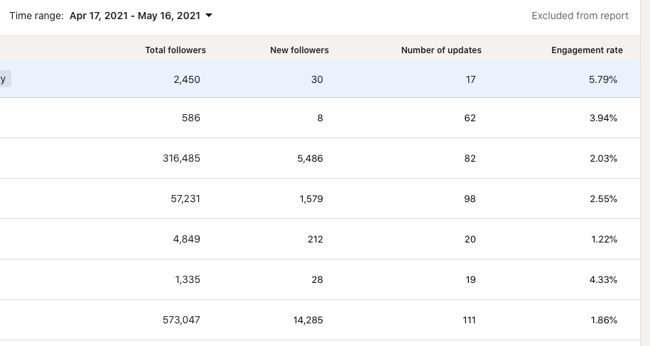 Image credit: LinkedIn Company Page Analytics - Competitors
Image credit: LinkedIn Company Page Analytics - Competitors
Metrics on native platforms: Pinterest
- Useful data for e-commerce brands or those running ads
- Audience insights: find out what other popular or related categories your audience takes an interest in
- Get an overview of your top pins by engagement, impressions, and outbound clicks
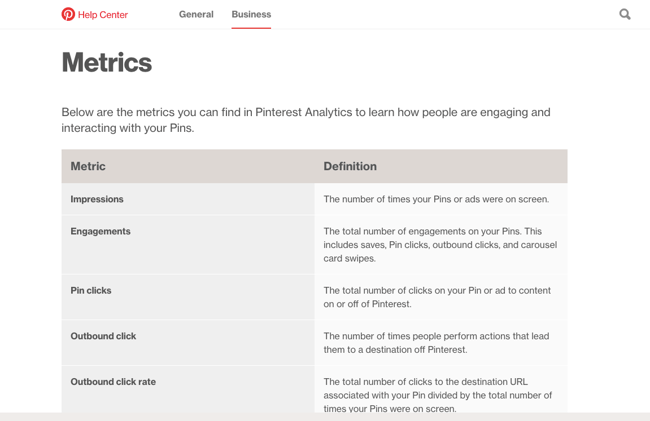 Image credit: Pinterest Analytics
Image credit: Pinterest Analytics
Tracking social media success in third-party tools like Sendible
You're most likely already using a scheduling tool to streamline how you publish content on social. With the different social media platforms available nowadays, it's essential to streamline the process so you can reach your social media goals.
That said, if your tool also offers analytics as part of the plan or subscription, you can gain insightful data that is accumulated across different networks.
For example, with Sendible,you get data on the 'best time to post' and 'top posts' data to inform your future social media marketing strategy. Plus, you can track how engaged your target audience is across all platforms in a single report.
You can also build tailored reports and automate them by letting us automatically collate data for the set time period and send it off to your clients or the internal team.
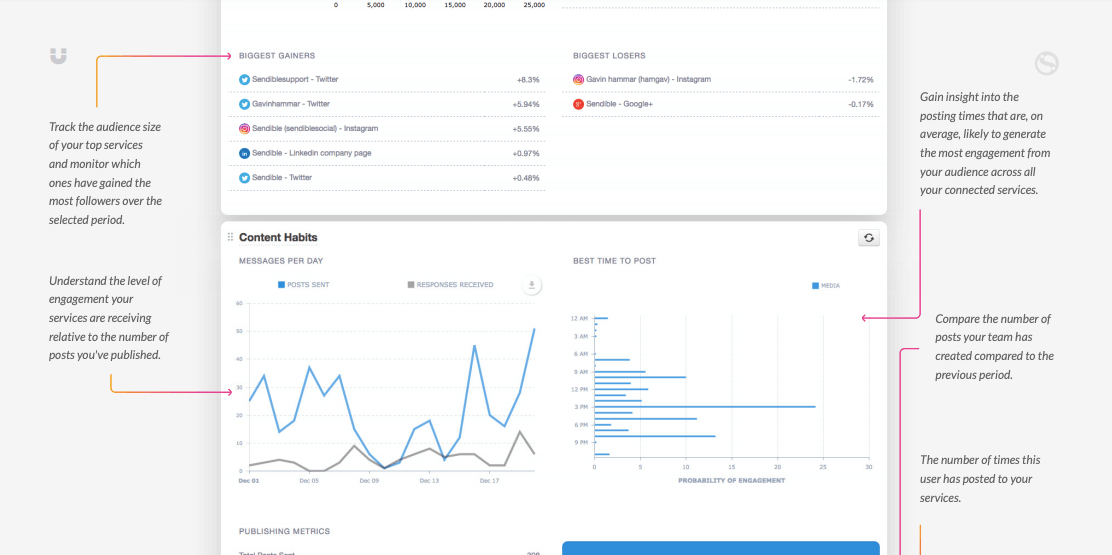 Image credit: Sendible's quick reports
Image credit: Sendible's quick reports
[Advanced] Using UTMs for better campaign tracking
If you've heard about most of the above, are you also adding UTM (Urchin Tracking Module) tracking to your links? If not, make sure to try them!
Adding UTM parameters to your links as part of your social media strategy makes it easier to quantify results for individual social media campaigns and better understand which pieces of content drive the biggest growth.
If you're on the highest plan with Sendible, you can build them in the app. If you don't, you can use Google's Campaign URL Builder.
🎥 Related: Watch our team's deep dive into Sendible's custom tags and UTM options if you'd like to see how it works.
How to adapt your social media strategy based on poorer performance
Any field in content marketing is ever-changing. Which means that your social media goals and social media strategy should also be ever-changing.
What works for one brand doesn't necessarily work for another, and just because your social media campaign was successful last year doesn't mean you can replicate it again with equal or greater success!
It's key to remember to keep adjusting your digital marketing strategy based on the results you see - whether you track them via hard-set KPIs or SMART goals.
There are two main directions when planning ahead:
- 📈 If the numbers are going UP, keep doing what you're doing, and make small improvements.
- 📉 If the numbers are going DOWN, you'll need to amend your marketing strategy and try something new.
To avoid some unnecessary stress, we're covering the three most common issues you may experience and what you can do about them!
- lower engagement rates (relevant to awareness goals)
- losing followers (relevant to awareness and community-building goals)
- a drop in website traffic (relevant to lead generation and sales goals)
Performance issue #1: Lower engagement on posts than usual
First off, be realistic: a 1-2% engagement rate on posts is a good score! That means that for every 1000 people that follow a brand, 10-20 likes, shares, and comments is actually a pretty good result.
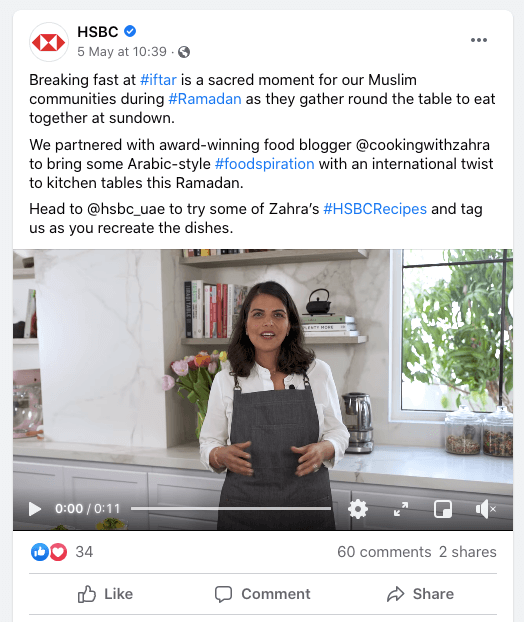 Image credit: HSBC
Image credit: HSBC
Consider the brand's target audience and how they usually engage with similar companies. It's worth remembering that not all brands are created equal, so an exciting cult beauty product will be getting significantly more engagement than an emergency plumbing services company. And that's OK!
Try experimenting with different social media content ideas and types. See if your audience prefers video over static images or if they're looking for more entertainment or useful information.
And don't forget to actively engage on the native platforms and ramp up the monitoring! Social media algorithms love it when you engage with others, so make sure you reply to every comment you get, even if it's just a few words and emojis.
Performance issue #2: Losing followers or not gaining any
A big part of your social media strategy and one of your social media goals is probably growing your following. If your follower count is not growing, it may be down to the audience not understanding the value of following your brand in the first place.
One reason for slow follower growth could be due to sharing too much sales content or not sticking to the same themes.
Make sure to set up solid content pillars to keep your feed interesting (and relevant) to new and existing followers.
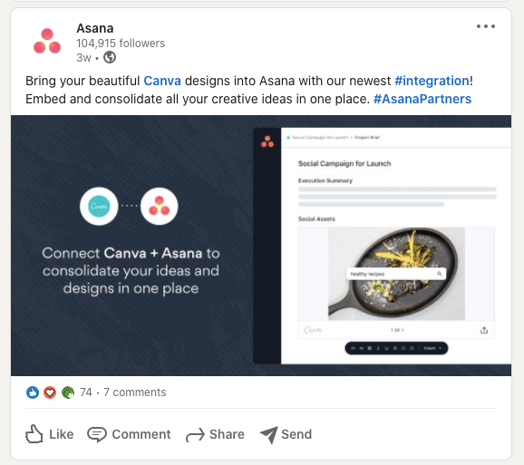 Image credit: Asana
Image credit: Asana
If the content is varied enough, but you're still not seeing traction, investigate if you're providing enough value. Invest time in better understanding the brand's marketing personas and ideal customers, their pain points, and goals to create valuable content.
Finally, another reason could be a lack of consistency in your posting schedule. Far too many brands share too much at once and then go silent for weeks. Having a strong and consistent social media presence is essential to your brand's success. Plan your content out for weeks or even months in advance, and use a social media scheduling tool that will help you streamline the process.
Performance issue #3: A drop in traffic from social media
This one can be a tough cookie to crack, but if your social media goals are closely tied to generating sales or traffic, you'll need to be actively monitoring social media referral traffic to your site.
If you do notice a drop, the first thing to do is to analyse which pages are receiving less (or more) traffic.
Check for any seasonality patterns - every brand experiences a jump or dip in sales at certain times of the year. It's also helpful to look at other channels, like organic, to see if you're seeing less website traffic or just social.
The next thing to do is to review your social media campaigns and their CTAs. Analyse if it's the offer or the content that's not driving enough interest as the solution to fixing either of these issues will differ.
Finally, if you actively run ads, this may be related to your ad spend or ad effectiveness which is a whole different story!
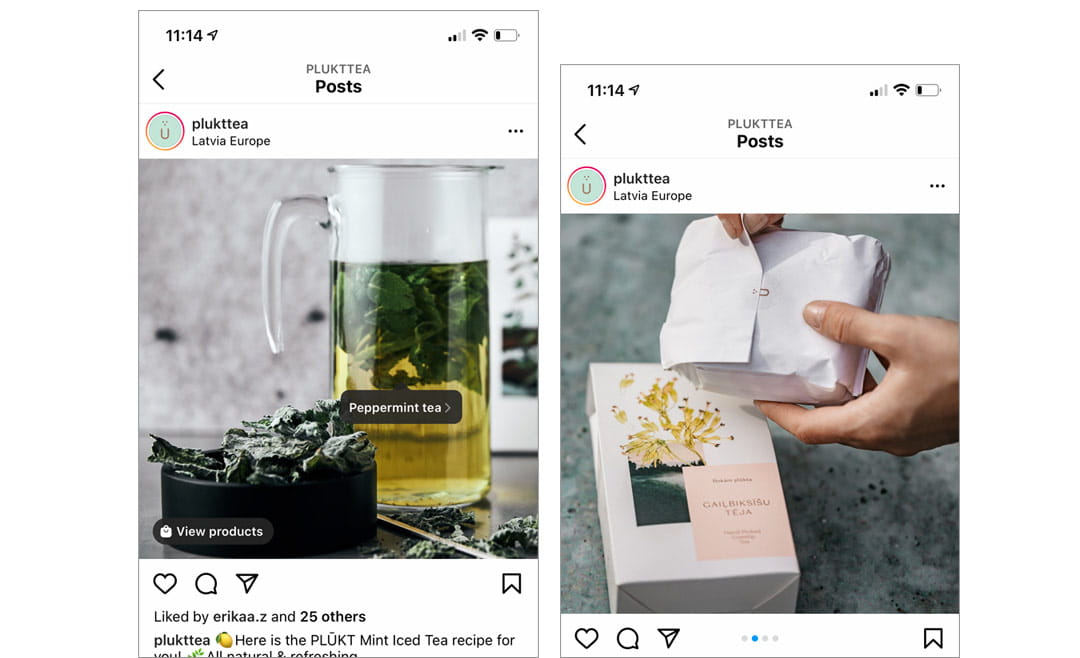 Image credit: @pluktea
Image credit: @pluktea
Prefer to learn visually? Watch our webinar recording on setting measurable social media goals 👇
We recently hosted a webinar on how to set up and measure social media goals when you're an agency or an in-house brand.
Watch back the recording if you prefer to get all the content of this article in a 20 or so minute video.
Over to you
That's it for our quick guide to goal-setting on social media. We hope this article will help you stay focused and prove useful when you're considering which KPIs are most relevant to different types of businesses.
As with anything related to social media, it's way too easy to lose track and get distracted by the next shiny feature or platform, but it's important to always keep the broader objective in mind to help steer your decision-making in which efforts are more likely to drive the desired results.
The most important thing to remember when you're not smashing your social media marketing goals is that tracking results and understanding where you are at is already part of the solution. So keep at it and don't give up!
📚 Related: Do you manage social media on behalf of other brands? Head straight to our detailed, no-fluff guide on starting and growing your social media marketing agency, covering everything from packaging your services and streamlining your workflow.

